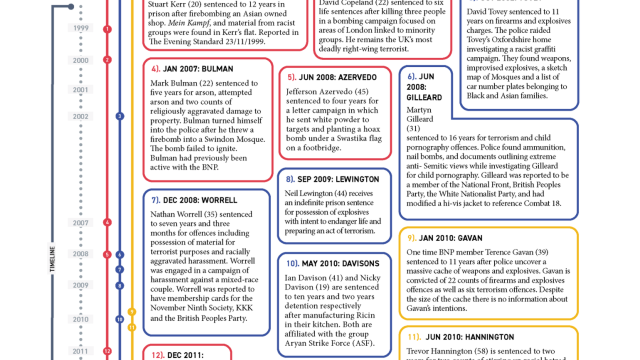There is a lack of data regarding prosecution and sentencing for terrorism and terrorism-related offences across the three legal jurisdictions of the UK (England and Wales, Scotland, and Northern Ireland). This project employed a review of relevant literature, interviews with stakeholders, analysis of judges’ sentencing remarks, and creation and analysis of a sentencing database (2001-2022) to answer key research questions about the prosecution landscape. The three main research questions were:
- What criminal offences (terrorism offences, terrorism-related, and violent extremism) are extremist actors being convicted of? Does type of offence differ based on extraneous factors such as ideological motivation and gender?
- What sentences are being imposed, and do sentences differ based on extraneous factors such as ideological motivation and gender?
- Is there any evidence of changes in sentencing over time that align with the introduction of sentencing guidelines in England & Wales, or major terrorism events?
Related to RQ1, results demonstrate that NI-related extremist actors are far more likely to be convicted of terrorism-related offences than terrorism or violent extremism offences. This is one of the clearest differences evident from the data. To a lesser extent, right-wing offenders are more likely than other motivation groups to be convicted of violent extremism offences, and Islamist offenders are more likely to be convicted of terrorism offences.
Related to RQ2, sentence length is influenced by offence type, plea, and total counts (all variables with legitimate impacts), but sentence length is also impacted by extraneous factors of gender and co-accused (i.e., whether an offender has co-defendants). Despite qualitative evidence to the contrary, ethnicity (white or non-white), age of an offender, and their ideological motivation were not shown to have an impact on sentences. According to the model, an individual most likely to receive the longest sentence would be a male with co-defendants, who does not plead guilty, is accused of multiple counts, and is charged under a terrorism-related offence.
Related to RQ3, sentence length has remained relatively steady over time (despite indications that it has increased). Number of offenders sentenced has fluctuated over time, with spikes in numbers appearing to align with contextual changes (including an increase in number of right-wing offenders sentenced after a clamp down in 2016). Analysis of all cases in E&W reveals no overall difference in sentences after implementation of the 2018 guidelines, but analysis of specific sections (s. 5, s. 58, and s. 2) reveals increases in sentences post-guidelines in each case.
Overall, despite qualitative evidence and indications from other sources that the prosecution of extremist actors is inconsistent across variables including ethnicity, age, and ideological motivation, we did not find an impact of these extraneous variables. This is positive evidence in favour of consistent use of legislation and sentencing sources, despite reports to the contrary. Differences were found relating to gender (women receive shorter sentences than men) and co-accused (having co-defendants increases sentences). We also found that ideological groups differ in offence type they are most likely to be convicted of, and that this may have indirect effects on sentencing. These are considerations in striving for consistency in the implementation of legislation and sentencing sources.
Read more
Agresti, A. (2007) An introduction to categorical data analysis. 2nd Edition, Hoboken, NJ: Wiley.
Ahmed, S. (2017) ‘Is history repeating itself: Sentencing young American Muslims in the war on terror’, Yale Law Journal, Vol. 126(5), pp. 1520-1576.
Alexander, A. and Turkington, R. (2018) ‘Treatment of terrorists: How does gender affect justice?’, CTC Sentinel, Vol.11(8), pp. 24-29.
Allen, R. (2016) ‘The Sentencing Council for England and Wales: Brake or Accelerator on the Use of Prison?’, Transform Justice, available online at http://www.transformjustice.org.uk/wp-content/uploads/2016/12/TJ-DEC-8.12.16-1.pdf.
Allen, G., Burton, M. and Pratt, A. (2022) Terrorism in Great Britain: the statistics. Commons Library Research Briefing. London: House of Commons Library.
Amirault, J. and Bouchard, M. (2017) ‘Timing is everything: The role of contextual and terrorism-specific factors in the sentencing outcomes of terrorist offenders’, European Journal of Criminology, Vol. 14(3), pp. 269-289.
Amirault, J. and Bouchard, M. (2015) ‘A group-based recidivist sentencing premium? The role of context and cohort effects in the sentencing of terrorist offenders’, International Journal of law, Crime and Justice, Vol. 43(4), pp. 512-534.
Amirault, J., Bouchard, M., Farrell, G. & Andresen, M.A. (2016) ‘Criminalizing terrorism in Canada: Investigating the sentencing outcomes of terrorist outcomes of terrorist offenders from 1963-2010’, Journal of Criminal Law & Criminology, Vol. 106(4), pp. 769-810.
Anderson, D. (2013) The Terrorism Acts in 2012: Report of the Independent Reviewer of Terrorism Legislation on the Operation of the Terrorism Acts 2000 and 2006. Available at: https://terrorismlegislationreviewer.independent.gov.uk/the-terrorism-acts-in-2012/
Anti-Terrorism Crime and Security Act 2001, available at: https://www.legislation.gov.uk/ukpga/2001/24/contents
Appleton, C. and Walker, C. (2015) ‘The Penology of Terrorism’, in G. Lennon and C. Walker (eds.) The Routledge Handbook of Law and Terrorism (pp. 447-456). London: Routledge.
Ashworth, A. (2015) Sentencing and Criminal Justice. 6th Edition, Cambridge: Cambridge University Press.
Awan, I., Spiller, K. & Whiting, A. (2019) Terrorism in the Classroom. Cham: Springer International Publishing.
Bajwa, A.N. (2010) ‘Sentencing Terror Offences’, Criminal Law and Justice Weekly, Vol. 174, pp. 500-503.
BBC (2017) Nottingham man who got explosives fearing ‘Isis attack’ jailed, 12 January, available at: https://www.bbc.co.uk/news/uk-england-nottinghamshire-38593289
Bell, J. (2004) ‘O Say, Can You See: Free Expression by the Light of Fiery Crosses’, Harvard Civil Rights-Civil Liberties Law Review, Vol. 39, pp. 335-389.
Bengtsson, M. (2016) How to plan and perform a qualitative study using content analysis, NursingPlus Open, Vol. 2, pp. 8-14.
Blackbourn, J. (2021) ‘Counterterrorism legislation and far-right terrorism in Australia and the United Kingdom’, Common Law World Review, Vol. 50(1), pp. 76-92.
Bradley-Engen, M.S., Damphousse, K.R. and Smith, B.L. (2009) ‘Punishing terrorists: A re-examination of U.S. federal sentencing in the postguidelines era’, International Criminal Justice Review, Vol. 19(4), pp. 433-455.
Bradley-Engen, M.S., Engen, R.L., Shields, C., Damphousse, K.R. and Smith, B.L. (2012) ‘The time penalty: Examining the relationship between time to conviction and trial vs. plea disparities in sentencing’, Justice Quarterly, Vol. 29(6), pp. 829-857.
Brown, G.D. (2014) ‘Punishing terrorists: Congress, the Sentencing Commission, the guidelines, and the courts’, Cornell Journal of Law and Public Policy, Vol. 23(3), pp. 517- 551.
Burtis, M. and Butler, L. (2021) ‘Friend or foe? An analysis of factors influencing sentence length in the prosecution of terrorism’, in M. Loadenthal (ed.) Prosecuting Political Violence: Collaborative Research and Method (pp. 68-91). Routledge: London.
Chesney, R.M. (2007) ‘Federal prosecution of terrorism-related offenses: Conviction and sentencing data in light of the “soft sentence” and “data reliability” critiques’, Lewis & Clark Law Review, Vol. 11(4), pp. 851-901.
Cohen, J. (1988) Statistical Power Analysis for the Behavioral Sciences. 2nd Edition, Hillsdale, NJ: Lawrence Erlbaum Associates, Publishers.
Counter-Terrorism and Border Security Act 2019, available at: https://www.legislation.gov.uk/ukpga/2019/3/contents/enacted/data.htm
Counter-Terrorism and Security Act 2015, available at: https://www.legislation.gov.uk/ukpga/2015/6/contents/enacted
Counter-Terrorism and Sentencing Act 2021, available at: https://www.legislation.gov.uk/ukpga/2021/11/contents/enacted
Crowley, M.G. (2010) ‘Terrorists: Challenging traditional sentencing principles in Australia?’, Federal Sentencing Reporter, Vol. 22(4), pp. 279-287.
Crown Prosecution Service (2015) Violent Extremism and Related Criminal Offences, available at: https://web.archive.org/web/201503291000146https://www.cps.gov.uk/publications/prosecution/violent_extremism.html
Crown Prosecution Service (2022) The Counter-Terrorism Division of the Crown Prosecution Service (CPS) - Successful prosecutions since 2016, available at: https://www.cps.gov.uk/crime-info/terrorism/counter-terrorism-division-crown-prosecution-service-cps-successful-prosecutions-2016
da Silva, R., Ventura, J.P., de Carvalho, C.M. and Barbosa, M.R. (2022) ‘“From street soldiers to political soldiers”: assessing how extreme right violence has been criminalised in Portugal’, Critical Studies on Terrorism, Vol. 15(1), pp. 102-120.
Damphousse, K.R. and Shields, C. (2007) ‘The morning after: Assessing the effect of major terrorism events on prosecution strategies and outcomes’, Journal of Contemporary Criminal Justice, Vol. 23(2), pp. 174-194.
Davies, C. (2019, June 21) ‘Isis suspect Jack Letts' parents found guilty of funding terrorism’, The Guardian, available at: https://www.theguardian.com/uk-news/2019/jun/21/jack-letts-isis-suspect-parents-found-guilty-of-funding-terrorism-oxford-syria
Dearden, L. (2017) ‘Mother who spread Isis propaganda on Facebook spared jail for terror offences due to children’s ‘suffering’’, The Independent, November 7. Available at: https://www.independent.co.uk/news/uk/crime/woman-isis-propaganda-facebook-jail-terror-offences-children-farhana-begum-ahmed-old-bailey-a8042196.html
Diab, R. (2011) ‘Sentencing for terrorism offences: A comparative review of emerging jurisprudence’, Canadian Criminal Law Review, Vol. 15(3), pp. 267-297.
Diab, R. (2013) ‘Sentencing of terrorism offences after 9/11: A comparative review of early case law’, in C. Forcese and F. Crepeau (eds.) Terrorism, law and democracy: Ten years after 9/11 (pp. 349-382). Montreal: Canadian Institute for the Administration of Justice.
Doerner, J. K. and Demuth, S. (2014). ‘Gender and Sentencing in the Federal Courts: Are Women Treated More Leniently’, Criminal Justice Policy Review, Vol. 25(2), pp. 242-269.
Explosive Substances Act 1883, available at: https://www.legislation.gov.uk/ukpga/Vict/46-47/3
Fleiss, J.L., Levin, B. and Myunghee, C.P. (2003) Statistical Methods for Rates and Proportions. 3rd Edition, New York: John Wiley & Sons.
Galica, N. (2020) ‘Lifting the veil: The impact of framing on sentencing disparities between males and females convicted of terrorism since the rise of ISIS’, UIC John Marshall Law Review, Vol. 53(1), pp. 113-162.
Gardham, D. (2015) ‘Young mother who stole her 'party girl' twin sister's passport so she could join ISIS in Syria for a second time is spared jailed so she can be with her young child’, Mail Online, July 31. Available at: https://www.dailymail.co.uk/news/article-3181556/Young-mother-stole-party-girl-twin-sister-s-passport-join-ISIS-Syria-second-time-spared-jailed-young-child.html
Gill, P. (2020) ‘The data collection challenge: Experiences studying lone-actor terrorism’, Resolve Network, February, pp. 1-20.
Goulette, N., Wooldredge, Frank, J. and Travis, L. (2015) ‘From Initial Appearance to Sentencing: Do Female Defendants Experience Disparate Treatment?’, Journal of Criminal Justice, Vol. 43(5), pp. 406-417.
GOV.UK. (ND) Ethnicity facts and figures, available at: https://www.ethnicity-facts-figures.service.gov.uk/style-guide/ethnic-groups
Hall, J.H. (2023) The Terrorism Acts in 2021: Report of the Independent Reviewer of Terrorism Legislation on the Operation of the Terrorism Acts 2000 and 2006. Available at: https://terrorismlegislationreviewer.independent.gov.uk/terrorism-acts-in-2021/
Hall, J.H. (2022) The Terrorism Acts in 2020: Report of the Independent Reviewer of Terrorism Legislation on the Operation of the Terrorism Acts 2000 and 2006. Available at: https://terrorismlegislationreviewer.independent.gov.uk/terrorism-acts-in-2020/
Hall, J.H. (2021) The Terrorism Acts in 2019: Report of the Independent Reviewer of Terrorism Legislation on the Operation of the Terrorism Acts 2000 and 2006. Available at: https://terrorismlegislationreviewer.independent.gov.uk/second-annual-review-on-terrorism-in-the-uk/
Harms, J. (2017) ‘The war on terror and accomplices: An exploratory study of individuals who provide material support to terrorists’, Security Journal, Vol. 30(2), pp. 417-436.
Her Majesty’s Government (2015) Counter-Extremism Strategy. London: Home Office.
Home Office (2021) Policy Paper Proscribed Terrorist Groups or Organisation, available at https://www.gov.uk/government/publications/proscribed-terror-groups-or-organisations--2/proscribed-terrorist-groups-or-organisations-accessible-version
Home Office (2023a) Statistics on the operation of police powers under the Terrorism Act 2000: Quarterly update to December 2022: Annual data tables, available at: https://www.gov.uk/government/statistics/operation-of-police-powers-under-the-terrorism-act-2000-quarterly-update-to-december-2022
Home Office (2023b) Operation of police powers under the Terrorism Act 2000 and subsequent legislation: Arrests, outcomes, and stop and search, Great Britain, year ending December 2022, available at: https://www.gov.uk/government/statistics/operation-of-police-powers-under-the-terrorism-act-2000-quarterly-update-to-december-2022/operation-of-police-powers-under-the-terrorism-act-2000-and-subsequent-legislation-arrests-outcomes-and-stop-and-search-great-britain-quarterly-u#court-proceedings
Jackson, S.M., Ratcliff, K. and Gruenewald, J. (2021) ‘Gender and Criminal Justice Responses to Terrorism in the United States’, Crime & Delinquency. doi: 10.1177/00111287211047535.
Johnson, B.D. (2012) ‘Cross-classified multilevel models: An application to the criminal case processing of indicted terrorists’, Journal of Quantitative Criminology, Vol. 28(1), pp. 163-189.
Joint Statement by Her Majesty’s Attorney General and the Lord Advocate (2009) Handling of terrorist cases where the jurisdiction to prosecute is shared by prosecuting authorities within the UK, available at: https://www.copfs.gov.uk/publications/terrorist-cases-joint-working-within-the-uk/
Jupp, J. (2022) ‘From Spiral to Stasis? United Kingdom counter-terrorism legislation and extreme right-wing terrorism’, Studies in Conflict & Terrorism, doi: 10.1080/1057610X.2022.212271
Koehler, D. (2019) ‘Violence and Terrorism from the Far-Right: Policy Options to Counter an Elusive Threat’, ICCT Policy Brief. doi: 10.19165/2019.2.02
Lammy, D. (2017) The Lammy Review: An independent review into the treatment of, and outcomes for Black, Asian and Minority Ethnic individuals in the criminal justice system. The Lammy Review: London.
Landis, J.R. and Koch, G.G. (1977) ‘The Measurement of Observer Agreement for Categorical Data’, Biometrics, Vol. 33(1), pp. 159-174.
Lee, F. and Walker, C. (2022a) ‘The sentencing of precursor terrorism crimes in the United Kingdom’ in C. Walker, M.L. Anglí and M.C. Meliá (eds.), Precursor crimes of terrorism (pp. 316-334.) Cheltenham: Edward Elgar.
Lee, F. and Walker, C. (2022b) ‘The Counter-Terrorism and Sentencing Act 2021 and the advance of intensified terrorism punishment’, Criminal Law Review, Issue 11, pp. 864-892.
Lowe, D. (2021) ‘Determining extremist behaviour: Differentiating between freedom of expression, legitimate political commentary, and hate’ in D. Lowe and R. Bennett (eds.) Helping the vulnerable being drawn towards terrorism or another layer of state surveillance (pp. 51-72). Abingdon: Routledge.
Lowe, D. (2020) ‘Far-right extremism: Is it legitimate freedom of expression, hate crime, or terrorism’, Terrorism and Political Violence, doi: 10.1080/09546553.2020.1789111
Makin, D.A. and Hoard, S. (2014) ‘Understanding the gender gap in domestic terrorism through criminal participation’, Criminal Justice Policy Review, Vol. 25(5), pp. 531-552.
McGarrity, N. (2013) “‘Let the punishment match the offence’: Determining sentences for Australian terrorists’, International Journal for Crime and Justice, Vol. 2(1), pp. 18-34.
Murray, K. (2018) ‘A comparative analysis of conviction outcomes of American domestic terrorist’, International Journal of Comparative and Applied Criminal Justice, Vol. 42(1), pp. 75-88.
Nesbitt, M. (2021) ‘Violent crime, hate speech or terrorism? How Canada views and prosecutes far-right extremism (2001-2019)’, Common Law World Review, Vol. 50(1), pp. 38-56.
Nesbitt, M. (2019) ‘An empirical study of terrorism charges and terrorism trials in Canada between September 2001 and September 2018’, Criminal Law Quarterly, Vol. 67(1-2), pp. 95-139.
Nesbitt, M. and Hagg, D. (2020) ‘An empirical study of terrorism prosecutions in Canada: Elucidating the elements of offences’, Alberta Law Review, Vol. 57(3), pp. 595-648.
Nesbitt, M., Oxoby, R. and Potier, M. (2019) An empirical and qualitative assessment of terrorism sentencing decisions in Canada since 2001: Shifting away from the fundamental principle and towards cognitive biases. IZA – Institute of Economics, IZA DP No. 12255.
Norris, J.J. (2020) ‘When (and where) can right-wing terrorists be charged with terrorism?’, Critical Studies on Terrorism, Vol 13(4), pp. 519-544.
Northern Ireland Office (2022) Northern Ireland Terrorism Legislation: Annual Statistics April–December 2020/21. Belfast: NIO.
O’Connell, F. (2011) Comparative Research in Sentencing Guidelines Mechanisms. Northern Ireland Assembly, Research and Information Service Research Paper (NIAR 610-10).
Offences against the Person Act 1861, available at https://www.legislation.gov.uk/ukpga/Vict/24-25/100/contents
Pina-Sánchez, J. and Harris, L (2020) ‘Sentencing gender? Investigating the presence of gender disparities in Crown Court sentences’, Criminal Law Review, Issue 1, pp. 3-28.
Pina-Sánchez, J., Lightowlers, C. and Roberts, J. (2017) ‘Exploring the punitive surge: Crown Court sentencing practices before and after the 2011 English riots’, Criminology & Criminal Justice, Vol. 17(3), pp. 319-339.
Prevention of Terrorism Act 2005, available at: https://www.legislation.gov.uk/ukpga/2005/2/enacted
Prevention of Terrorism (Temporary Provisions) Act 1989, available at https://www.legislation.gov.uk/ukpga/1989/4/contents
Public Order Act 1986, available at: https://www.legislation.gov.uk/ukpga/1986/64
Said, W.E. (2014) ‘Sentencing Terrorist Crimes’, Ohio State Law Journal, Vol. 75(3), pp. 478-528
Sentencing Council (2022) Terrorism Offences: Data Tables. Available at: https://www.sentencingcouncil.org.uk/publications/item/terrorism-offences-data-tables-2/
Sentencing Council (2018) Terrorism Offences: Definitive Guide. Available at https://www.sentencingcouncil.org.uk/publications/item/terrorism-offences-definitive-guideline/
Sentencing Council (2017) Reduction in Sentence for Guilty Plea: Definitive Guide. Available at https://www.sentencingcouncil.org.uk/publications/item/reduction-in-sentence-for-a-guilty-plea-definitive-guideline/
Shields, C.A., Damphousse, K.R. and Smith, B.L. (2006) ‘Their day in court: Assessing guilty plea rates among terrorists’, Journal of Contemporary Criminal Justice, Vol 22(3), pp. 261-276.
Shields, C.A., Smith, B.L. and Damphousse, K.R. (2016) ‘Prosecuting terrorism post‐9/11: impact of policy changes on case outcomes’ in G. LaFree and J.D. Freilich (eds.) The handbook of the criminology of terrorism (pp. 495-507.) Chichester: John Wiley & Sons, Inc.
Smith, B.L. and Damphousse, K.R. (1996) Punishing political offenders: The effect of political motive on federal sentencing decisions’, Criminology, Vol. 34(3), pp. 289-319.
Smith, B.L., Damphousse, K.R., Jackson, F. and Sellers, A. (2002) ‘The prosecution and punishment of international terrorists in federal courts: 1980–1998’, Criminology & Public Policy, Vol. 1(3), pp. 311-338.
Smith, B.L., Damphousse, K.R., Yang, S. and Ginther, C. (2005) ‘Prosecuting politically motivated offenders: The impact of the “terrorist” label on criminal case outcomes’, International Journal of Contemporary Sociology, Vol. 42(2), pp. 209-226.
Smith, B.L. and Orvis, G.P. (1993) ‘America’s response to terrorism: An empirical analysis of federal intervention strategies during the 1980s’, Justice Quarterly, Vol. 10(4), 661-682.
Spohn, C. (2014) ‘Racial Disparities in Prosecution, Sentencing, and Punishment’, in S. Bucerius and M. Tonry (eds.) The Oxford Handbook of Ethnicity, Crime and Immigration (pp. 166-193). Oxford University Press: Oxford.
Stephens, N.L. (2020) ‘Doing more good than harm: Alternatives to incarceration for young people charged with crimes of terrorism’, Fordham Urban Law Journal, Vol. 48(1), pp. 198-253.
Stone, N. (2022a) ‘Sentencing Children for Violent Extremism: Part 1’, Youth Justice, Vol. 22(1), pp.101–108.
Stone, N. (2022b) ‘Sentencing Children for Violent Extremism: Part 2’, Youth Justice, Vol. 22(2), pp. 222–231.
Stuart, H. (2017a) Islamist terrorism: Analysis of offences and attacks in the UK (1998-2015). London: The Henry Jackson Society.
Stuart, H. (2017b) Islamist terrorism: Key findings and analysis. London: The Henry Jackson Society.
Terrorism Act 2000, available at: https://www.legislation.gov.uk/ukpga/2000/11/contents
Terrorism Act 2006, available at: https://www.legislation.gov.uk/ukpga/2006/11/contents
Terrorist Offenders (Restriction of Early Release) Act 2020, available at: https://www.legislation.gov.uk/ukpga/2020/3/contents
Terrorism Prevention and Investigation Measures Act 2011, available at: https://www.legislation.gov.uk/ukpga/2011/23/contents
Vidino, L. and Hughes, S. (2015) ISIS in America: From retweets to Raqqa. Washington DC: Program on Extremism, The George Washington University.
Walker, C. (2011) Terrorism and the law. Oxford: Oxford University Press.
Walker, C. (2020) ‘Terrorism prosecutions and the right to a fair trial’, in B. Saul (ed.) Research handbook on international law and terrorism (pp. 384- 398). Cheltenham: Edward Elgar Publishing.
Weaver, M. and Doty, A. (2021) ‘Gender, jail, and justice: Gender interaction effects on judicial sentencing rhetoric’, in M. Loadenthal (ed.), Prosecuting Political Violence: Collaborative Research and Method (pp. 132-150). London: Routledge.
Winter, C., Neumann, P., Meleagrou-Hitchens, A., Ranstorp, M., Vidino, L. & Fürst, J. (2020) ‘Online Extremism: Research Trends in Internet Activism, Radicalization, and Counter-Strategies’, International Journal of Conflict and Violence, Vol. 14(2), pp. 1-20.
Yon, R. and Milton, D. (2021) ‘Examining the outcome of investigations and prosecutions of extremism in the United States’, Studies in Conflict & Terrorism, DOI: 10.1080/1057610X.2021.1987659
Zedner, L. (2021) ‘Countering terrorism or criminalizing curiosity of UK responses to right-wing and other extremism’, Common Law World Review, Vol. 50(1), pp. 57-75.
Copyright Information
As part of CREST’s commitment to open access research, this text is available under a Creative Commons BY-NC-SA 4.0 licence. Please refer to our Copyright page for full details.
IMAGE CREDITS: Copyright ©2024 R. Stevens / CREST (CC BY-SA 4.0)






